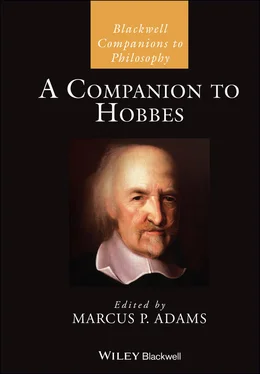Hobbes also replaces the starting points of syllogistic deductions typical of Scholastic scientific knowledge. Scholastic principles are universal claims about existing things known by means other than proof and consist in fundamental truths about the most general kinds of being. These include definitions of corporeal versus incorporeal substance that are further qualified to yield definitions of animate versus inanimate corporeal substances, and eternal versus finite incorporeal substances, and so on down the line. At each level, one can, taking the appropriate definition as one’s first premise, then demonstrate propter quid the properties that are implied by the essence captured by the definition of that species of being. Accordingly, from the definition of a human being as a rational animal, one can infer that humans are both mortal and capable of understanding. From such properties contained in the essence of a human being one then deduces further effects. There were, naturally, many obstacles to doing this in practice as well as doubts raised about the accurate capturing of essences by definitions. However, in principle, one could, by syllogizing, eventually deduce a comprehensive, consistent structure of true conclusions about the natural world, all ultimately derived from the same first principles. Hobbes’s characterizations of scientific knowledge and method signal that he retains this structure but rejects the existing foundation as untrue. Removing Scholastic metaphysics, and incorporeal substance from the domain of philosophy allows Hobbes to replace Scholastic definitions based on genera and species of substance with a “true foundation,” consisting in definitions of geometrical objects. 9
Hobbes further rejects Euclid’s definitions of the simplest geometrical entities, like point and line, instead embracing genetic, or generative definitions given by Hero of Alexandria. 10So, Hobbes not only proposes a different foundation from which syllogistic reasoning begins, but his foundational definitions or first principles are not standard Euclidean definitions, like the definition of a line as a breadthless length. Hobbes could be averting the criticism that the most basic Euclidean definitions do not capture the essential properties of geometrical entities. If Hobbes’s foundational geometrical definitions correspond to essential features of bodies, as did the first principles of the Scholastic structure of scientific knowledge, then his move is to recast essences as procedures or recipes for the production of an object. 11Following Hero, the proper definition of a geometrical object spells out how it is constructed: “a line is made by the motion of a point, superficies by the motion of a line, and one motion by another motion, & c” (EW I. 70–1). Based on such generative definitions, the passages quoted suggest that Hobbes regards scientific knowledge as a unified structure of conclusions ultimately deducible from generative definitions of geometry. As he outlines, one begins with lines or lengths generated from points in motion, and surfaces generated from long bodies – which once demonstrated, then allow one to construct definitions of the more complex phenomena of the science of motion, itself produced by the effects of one body’s motion on other bodies. Next, the science of motion provides the starting points for demonstrating the phenomena of physics, which are produced by the motions of the parts of bodies, including our sense organs. Likewise, De corpore suggests that having arrived at definitions of human passions, we can progress all the way up to civil science. Hence demonstrative knowledge of all sciences, including politics, will necessarily be generated from geometrical foundations and form a unified whole.
Interpreting Hobbes’s method as this kind of a generative construction fits one sense of “demonstration.” When discussing the proper method of demonstration in teaching, which he holds to be the same as the method of discovery, Hobbes invokes the original sense that “demonstration” had in ancient geometry:
that which the Greeks called ἀποδέιξις, and the Latins demonstratio , was understood by them for that sort only of ratiocination, in which, by the describing of certain lines and figures, they placed the thing they were to prove, as it were before men’s eyes, which is properly ἀποδεικνύειν, or to shew by the figure;
(EW I.86)
If scientific knowledge consists in demonstrations that prove effects from definitions specifying generative causes, in this geometrical sense of making objects visible (concretely or in the imagination) through construction, then Hobbes’s hierarchical structure of knowledge appears as a successive placing before our eyes of ever more complex objects that are built up from previously shown objects, just as a square is constructed from four lines, and the lines, in turn, are drawn by moving a point. 12The Commonwealth would sit at the pinnacle of this hierarchy, as the most complex object, built up of human bodies (themselves complex bodies generated by motions) whose passions and desire for peace make a social contract necessary. Two mechanical analogies suggest that Hobbes employs demonstration in this sense to methodically arrive at civil science. But since only artificial bodies of geometry and politics can be thus constructed this would imply that either physics lies outside of science, or Hobbes has distinct methods for theoretical and practical science. 13I argue, instead, that Hobbes has one method, but not a constructive method in this sense.
Hobbes’s use of mechanical analogies give the impression that civil science employs a method of mechanical construction at odds with method in physics. In De cive , Hobbes claims to have started from the matter of civil government “and thence proceeded to its generation and form, and the first beginning of justice. For everything is best understood by its constitutive causes” (EW II.xiv). Immediately thereafter he makes an analogy to a watch, which one must take apart to understand the matter, shape, and motion of the wheels. Similarly,
so to make a more curious search into the rights of states and duties of subjects, it is necessary, I say, not to take them insunder, but yet that they be so considered as if they were dissolved; that is, that we rightly understand what the quality of human nature is, in what matters it is, in what not, fit to make up a civil government, and how men must be agreed amongst themselves that intend to grow up into a well-grounded state.
(EW II.xiv)
In Leviathan , the Commonwealth or State is likened to an artificial person, which one can dissect into its component parts by analogy to the parts of an automaton. This analogy likewise suggests a kind of reverse-engineering methodology not possible with natural phenomena. Here too Hobbes employs Aristotelian notions of a form that is generated, and the matter, or constitutive causes, which once extracted through resolution, can then be recomposed in the correct way. A common interpretation equates Hobbes’s reference to resolution in this passage with his method of analysis in De corpore and aligns the re-composition with synthesis. Next I show that analysis and synthesis in De corpore are not a material resolution and re-composition. Here I argue that these analogies are rhetorical.
The automaton analogy precedes Hobbes’s description of the structure of his work, the Leviathan . He frames it in terms of the four causes familiar to his Aristotelian-schooled readers. First he treats of human beings, the matter, i.e., material cause, of this artificial body. Next, Hobbes invokes how the commonwealth is made by covenants, which to his readers would evoke its efficient cause. The last two sections of the book explain what a Christian commonwealth is and what the kingdom of darkness is, i.e., the final and formal causes (2012, 18; 1651, 2). Hobbes’s automaton analogy is a rhetorical visualization for the organic structure of his work, informing readers that he will present his theory starting from material and efficient causes and concluding with final and formal causes of the Commonwealth. Just as he does not thereby commit himself to a method that employs Aristotelian causes, his mechanical analogies do not commit him to a method of geometrical construction. Indeed, Hobbes’s De corpore clarifies that knowing scientifically is to syllogize from cause to effect.
Читать дальше












